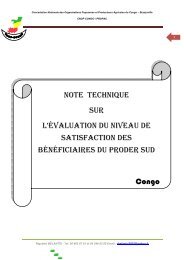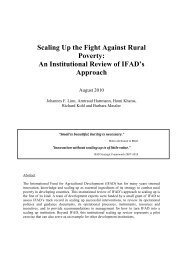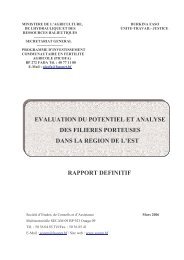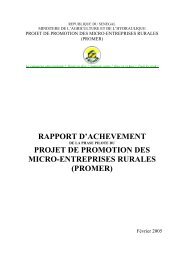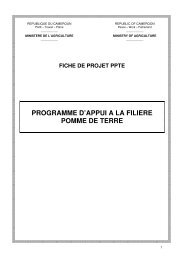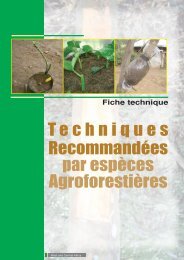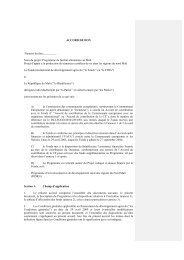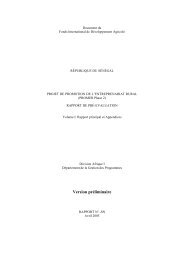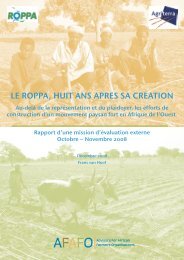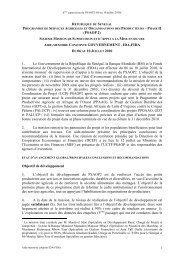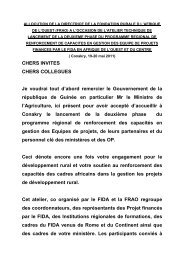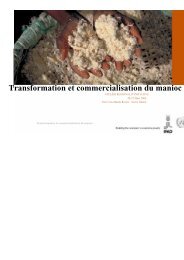Family: Irvingiaceae - FIDAfrique
Family: Irvingiaceae - FIDAfrique
Family: Irvingiaceae - FIDAfrique
You also want an ePaper? Increase the reach of your titles
YUMPU automatically turns print PDFs into web optimized ePapers that Google loves.
Bush mango<br />
Ando’o - Oba - Meba<br />
<strong>Family</strong>: <strong>Irvingiaceae</strong><br />
West and Central Africa<br />
West and Central Africa
Information slip<br />
Bush mango<br />
<strong>Family</strong>: <strong>Irvingiaceae</strong><br />
1. Species identity<br />
• Names<br />
Scientific name: Irvingia gabonensis (Aubry Lecomte)<br />
Common names: African mango tree, bush mango, dika nut, wild<br />
mango<br />
Vernacular names: (Cameroon) andok; ando’o; (Nigeria) oro, oba;<br />
(RDC) meba, mueba;<br />
• Botanical description<br />
Irvingia gabonensis grows to a height<br />
of 15-40 m, with bole slightly buttressed.<br />
Leaves range from elliptic to<br />
slightly obovate. Flowers can be yellowish<br />
to greenish-white, with slender<br />
individual flower stalks. Fruits are yellowish<br />
when ripe, broadly ellipsoid and<br />
variable in size, with a yellow, fibrous<br />
pulp surrounding a large seed. Botanical illustration<br />
A: flowering branch, B: Bud, C: flowering, D: stamina, E: pistil,<br />
F: longitudinal section of the flower, G: cross section of ovary,<br />
H: longitudinal section of the fruit<br />
2. Ecology and<br />
distribution<br />
• Natural habitat and<br />
geographical distribution<br />
Native of Angola, Cameroon, Central African<br />
Republic, Congo, Cote d'Ivoire, Democratic<br />
Republic of Congo, Equatorial Guinea, Gabon,<br />
Ghana, Guinea-Bissau, Liberia, Nigeria, Senegal,<br />
Sierra Leone, Sudan, Uganda. I. gabonensis<br />
occurs in the wild, in lowland forest; it is<br />
reported to be gregarious in some areas. The<br />
tree is a species also grows in the dense moist<br />
forest.
• Biophysical limit<br />
Bush mango can be found at altitude range between 200 - 500 m. Temperature range for<br />
growth is between 25 and 32°C with a minimum annual rainfall range of 1500 – 3000 mm. It<br />
grows well in well-drained, acidic clayey sandy soils (pH
4.3. Marcotting<br />
• Rooting medium: Topsoil, oil palm inflorescence,<br />
compost or peat and decomposed sawdust<br />
• Type and Diameter of branch: 2-4 cm<br />
• Time before rooting start: 3 months<br />
• Success rate at rooting: about 60% after 6 months<br />
• Survival rate after weaning: about 40%<br />
4.4. Grafting<br />
• Side tongue grafting, top cleft grafting<br />
• Survival rate: about 60%<br />
• Use I. wombolu as rootstock<br />
5. Planting and Management<br />
5.1. Planting<br />
In cultivating the Bush mango tree, only seedlings, rooted cuttings or marcotts that have spent<br />
at least 6 months under shade in the nursery can be transplanted. The recommended spacing<br />
for planting I.gabonensis in orchards is 10 x 10 m. Dig planting holes of 30 x 30 cm for seedlings,<br />
cuttings and grafted plants or 50 x 50 cm for marcotts.<br />
5.2. Management<br />
Weed 1 metre around the trees once every 2 months for the first year after planting. Apply NPK<br />
at a ratio of 20-10-10 and at the rate of 25 g/tree/year when the soil is poor. Do this at the<br />
beginning of the rainy season.<br />
6. Pests<br />
Unripe fruits are attacked by rodents, including squirrels, which gnaw through the mesocarp and<br />
the pyrene to reach the seed. Red forest pigs split the pyrenes open and eat the seeds.<br />
Bibliography and Further Reading<br />
• J. Vivien and J.J. Faure. 1996. Fruitiers Sauvages d’Afrique (Espèces du Cameroun). p 416<br />
• E. Asaah, R.P. Tchientche and Z. Tchoundjeu. Nutrient status and physical properties of soils<br />
in the natural habitat of Irvingia gabonensis (Aubry Lecomte ex O’Rorke) in Cameroon. In<br />
preparation<br />
• http://www.worldagroforestry.org/ SEA/Products/ AFDbases/AF/asp/<br />
SpeciesInfo.asp?SpID=1003<br />
• Illustrations : Bailey Hortorium, World Agroforestry Centre-West and Central Africa Region.<br />
Prepared by<br />
Ebenezer Asaah<br />
Régine Pakeujou Tchientche<br />
Dr. Marie Laure Mpeck<br />
Dr. Zac Tchoundjeu<br />
Catherine Momha<br />
For more information contact :<br />
World Agroforestry Centre-West and Central Africa<br />
Regional Office P.O. Box 16317 Yaounde-Cameroun<br />
Tel: (237) 22.21.50.84 / 22.23.75.60<br />
Fax: (237) 22.21.50.89 / 22.23.74.40<br />
E-mail: icraf-aht@cgiar.org<br />
Web site : worldagroforestrycentre.org/aht



